Mental Health Nursing Report: Samuel's Case Study Analysis
VerifiedAdded on 2020/03/13
|11
|2356
|43
Report
AI Summary
This report presents a detailed analysis of a mental health nursing case study involving a 25-year-old gay man named Samuel, who is diagnosed with Post-Traumatic Stress Disorder (PTSD) stemming from childhood trauma. The report begins with an introduction to Samuel's background, including his history of anxiety, substance use, and a past assault. A mental status examination is conducted, assessing his appearance, behavior, speech, mood, cognition, and thought patterns. A clinical formulation is provided using the 5P's framework, identifying predisposing, precipitating, perpetuating, and protective factors. The report then outlines a plan for nursing care based on Maslow's hierarchy of needs, emphasizing the importance of addressing Samuel's feelings of guilt and lack of parental support. Cognitive Behavioral Therapy (CBT) is identified as a key nursing intervention, with a description of its steps. The report also discusses the therapeutic relationship between Samuel and his case manager, cultural safety considerations in treatment, and recovery-oriented nursing care, including availability, accessibility, and acceptability of care. The report concludes with a list of relevant references.
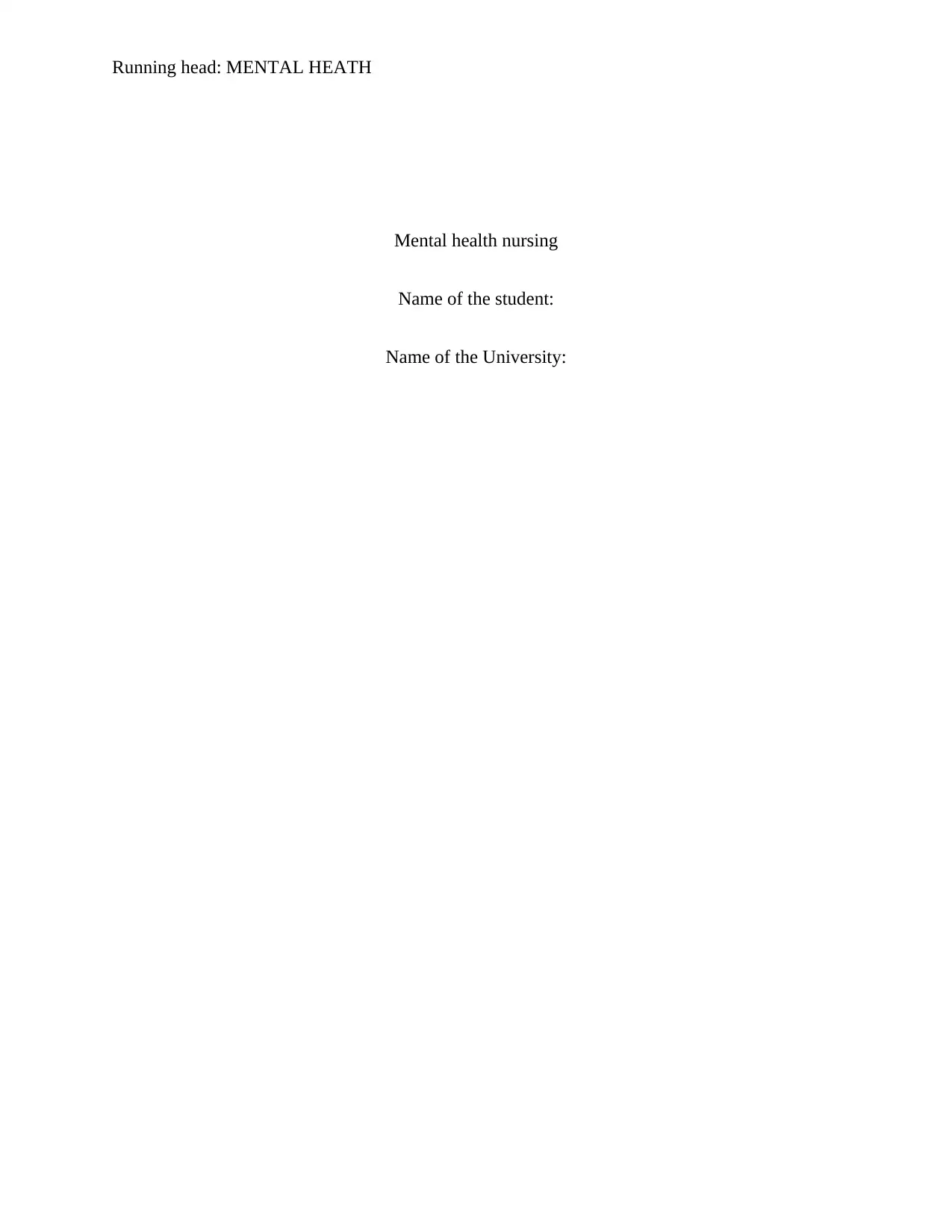
Running head: MENTAL HEATH
Mental health nursing
Name of the student:
Name of the University:
Mental health nursing
Name of the student:
Name of the University:
Paraphrase This Document
Need a fresh take? Get an instant paraphrase of this document with our AI Paraphraser
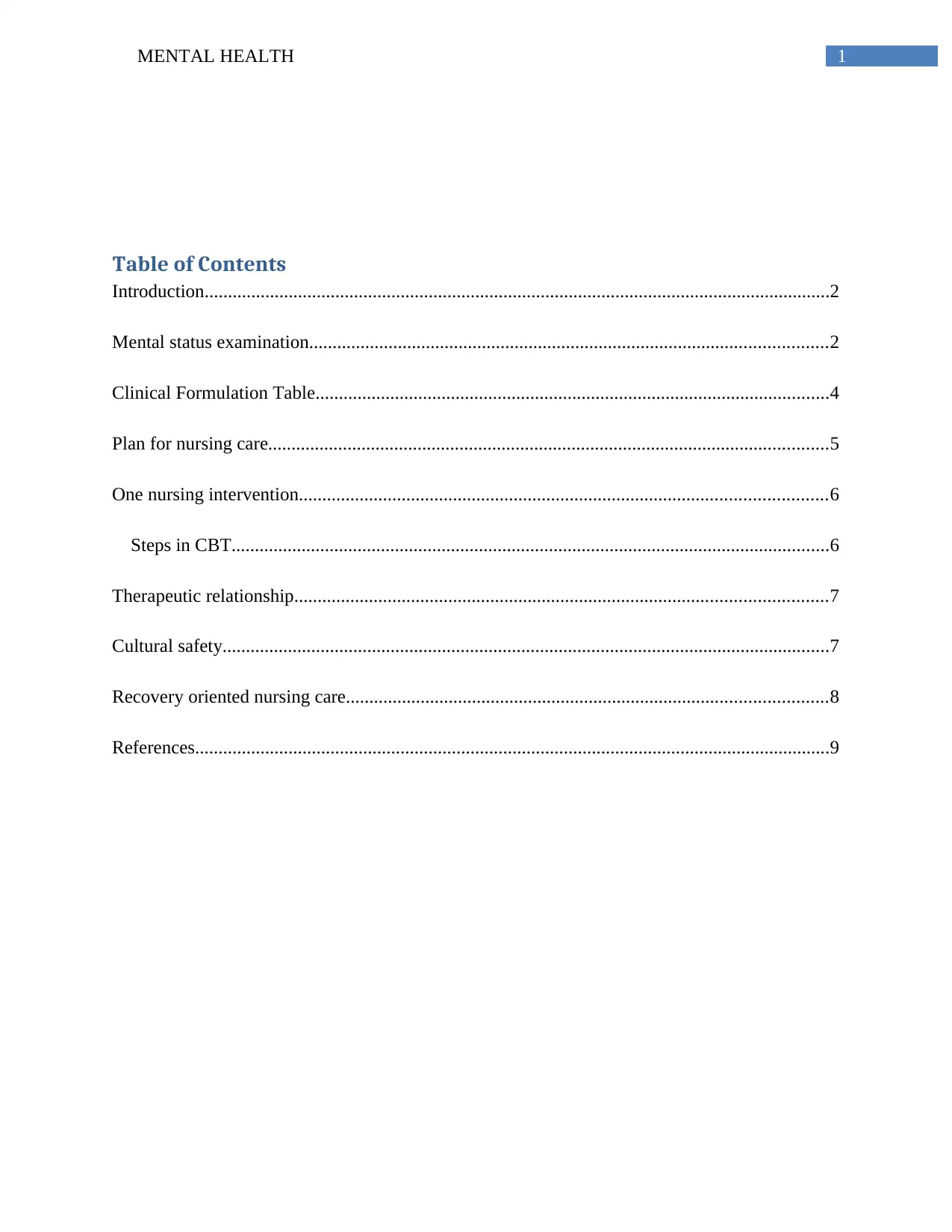
1MENTAL HEALTH
Table of Contents
Introduction......................................................................................................................................2
Mental status examination...............................................................................................................2
Clinical Formulation Table..............................................................................................................4
Plan for nursing care........................................................................................................................5
One nursing intervention.................................................................................................................6
Steps in CBT................................................................................................................................6
Therapeutic relationship..................................................................................................................7
Cultural safety..................................................................................................................................7
Recovery oriented nursing care.......................................................................................................8
References........................................................................................................................................9
Table of Contents
Introduction......................................................................................................................................2
Mental status examination...............................................................................................................2
Clinical Formulation Table..............................................................................................................4
Plan for nursing care........................................................................................................................5
One nursing intervention.................................................................................................................6
Steps in CBT................................................................................................................................6
Therapeutic relationship..................................................................................................................7
Cultural safety..................................................................................................................................7
Recovery oriented nursing care.......................................................................................................8
References........................................................................................................................................9
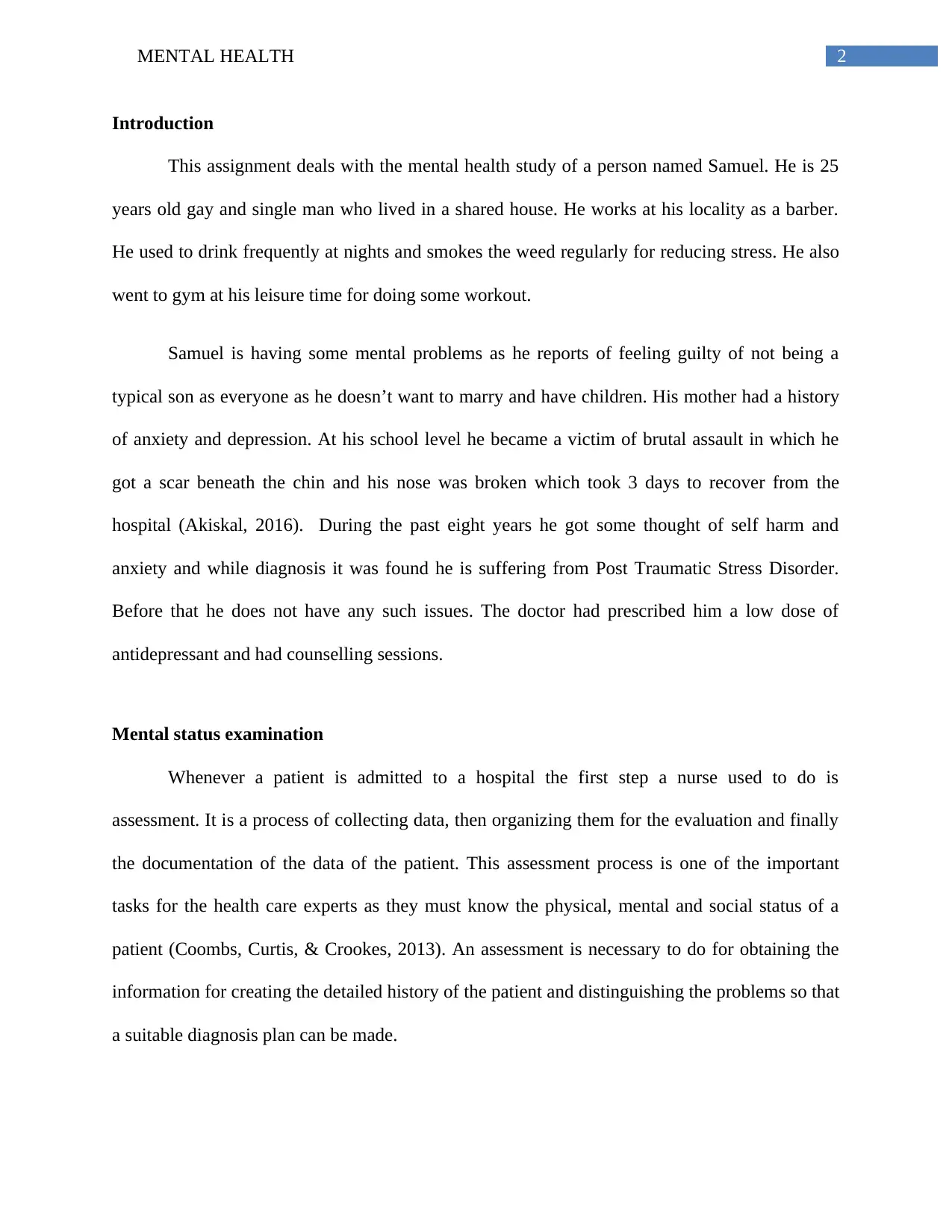
2MENTAL HEALTH
Introduction
This assignment deals with the mental health study of a person named Samuel. He is 25
years old gay and single man who lived in a shared house. He works at his locality as a barber.
He used to drink frequently at nights and smokes the weed regularly for reducing stress. He also
went to gym at his leisure time for doing some workout.
Samuel is having some mental problems as he reports of feeling guilty of not being a
typical son as everyone as he doesn’t want to marry and have children. His mother had a history
of anxiety and depression. At his school level he became a victim of brutal assault in which he
got a scar beneath the chin and his nose was broken which took 3 days to recover from the
hospital (Akiskal, 2016). During the past eight years he got some thought of self harm and
anxiety and while diagnosis it was found he is suffering from Post Traumatic Stress Disorder.
Before that he does not have any such issues. The doctor had prescribed him a low dose of
antidepressant and had counselling sessions.
Mental status examination
Whenever a patient is admitted to a hospital the first step a nurse used to do is
assessment. It is a process of collecting data, then organizing them for the evaluation and finally
the documentation of the data of the patient. This assessment process is one of the important
tasks for the health care experts as they must know the physical, mental and social status of a
patient (Coombs, Curtis, & Crookes, 2013). An assessment is necessary to do for obtaining the
information for creating the detailed history of the patient and distinguishing the problems so that
a suitable diagnosis plan can be made.
Introduction
This assignment deals with the mental health study of a person named Samuel. He is 25
years old gay and single man who lived in a shared house. He works at his locality as a barber.
He used to drink frequently at nights and smokes the weed regularly for reducing stress. He also
went to gym at his leisure time for doing some workout.
Samuel is having some mental problems as he reports of feeling guilty of not being a
typical son as everyone as he doesn’t want to marry and have children. His mother had a history
of anxiety and depression. At his school level he became a victim of brutal assault in which he
got a scar beneath the chin and his nose was broken which took 3 days to recover from the
hospital (Akiskal, 2016). During the past eight years he got some thought of self harm and
anxiety and while diagnosis it was found he is suffering from Post Traumatic Stress Disorder.
Before that he does not have any such issues. The doctor had prescribed him a low dose of
antidepressant and had counselling sessions.
Mental status examination
Whenever a patient is admitted to a hospital the first step a nurse used to do is
assessment. It is a process of collecting data, then organizing them for the evaluation and finally
the documentation of the data of the patient. This assessment process is one of the important
tasks for the health care experts as they must know the physical, mental and social status of a
patient (Coombs, Curtis, & Crookes, 2013). An assessment is necessary to do for obtaining the
information for creating the detailed history of the patient and distinguishing the problems so that
a suitable diagnosis plan can be made.
⊘ This is a preview!⊘
Do you want full access?
Subscribe today to unlock all pages.

Trusted by 1+ million students worldwide
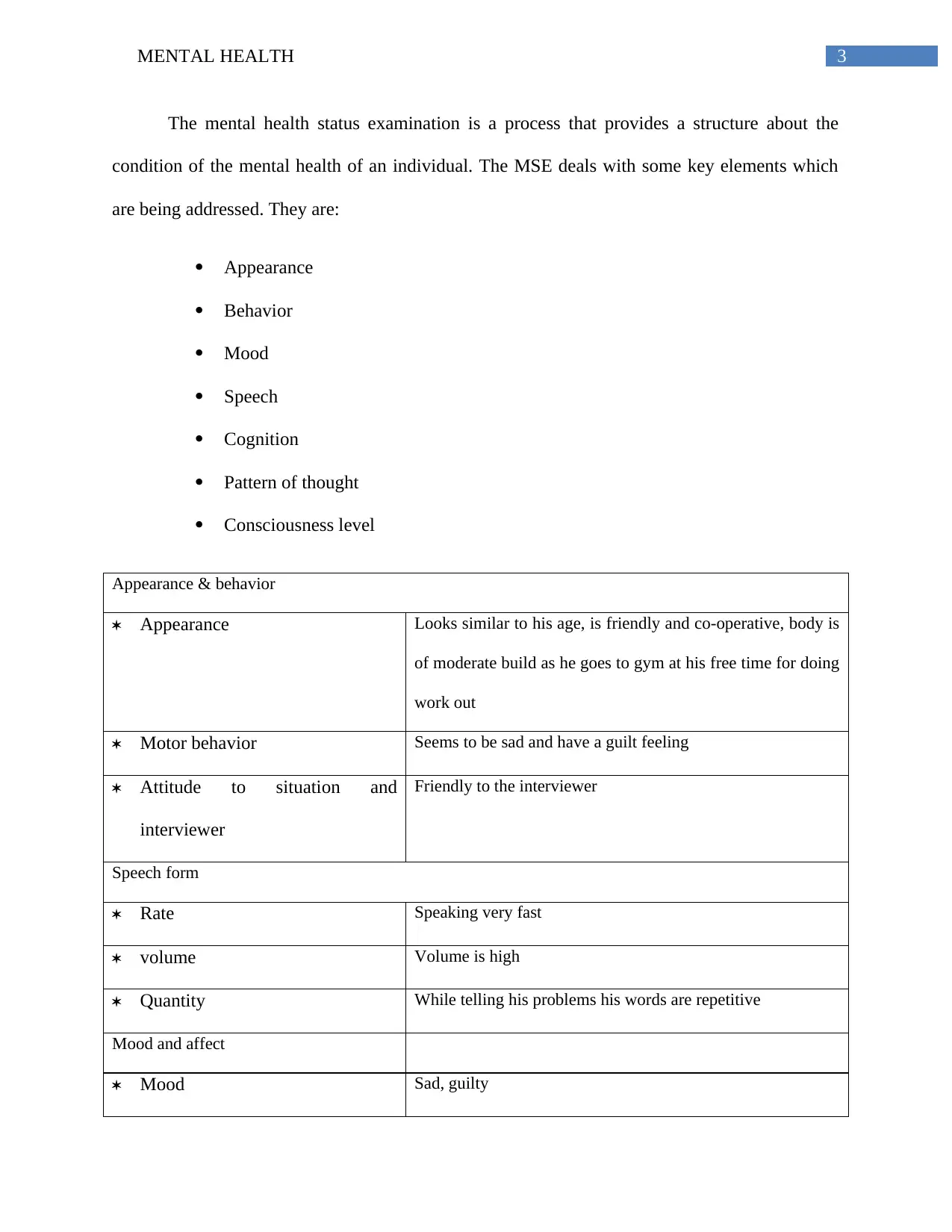
3MENTAL HEALTH
The mental health status examination is a process that provides a structure about the
condition of the mental health of an individual. The MSE deals with some key elements which
are being addressed. They are:
Appearance
Behavior
Mood
Speech
Cognition
Pattern of thought
Consciousness level
Appearance & behavior
Appearance Looks similar to his age, is friendly and co-operative, body is
of moderate build as he goes to gym at his free time for doing
work out
Motor behavior Seems to be sad and have a guilt feeling
Attitude to situation and
interviewer
Friendly to the interviewer
Speech form
Rate Speaking very fast
volume Volume is high
Quantity While telling his problems his words are repetitive
Mood and affect
Mood Sad, guilty
The mental health status examination is a process that provides a structure about the
condition of the mental health of an individual. The MSE deals with some key elements which
are being addressed. They are:
Appearance
Behavior
Mood
Speech
Cognition
Pattern of thought
Consciousness level
Appearance & behavior
Appearance Looks similar to his age, is friendly and co-operative, body is
of moderate build as he goes to gym at his free time for doing
work out
Motor behavior Seems to be sad and have a guilt feeling
Attitude to situation and
interviewer
Friendly to the interviewer
Speech form
Rate Speaking very fast
volume Volume is high
Quantity While telling his problems his words are repetitive
Mood and affect
Mood Sad, guilty
Paraphrase This Document
Need a fresh take? Get an instant paraphrase of this document with our AI Paraphraser
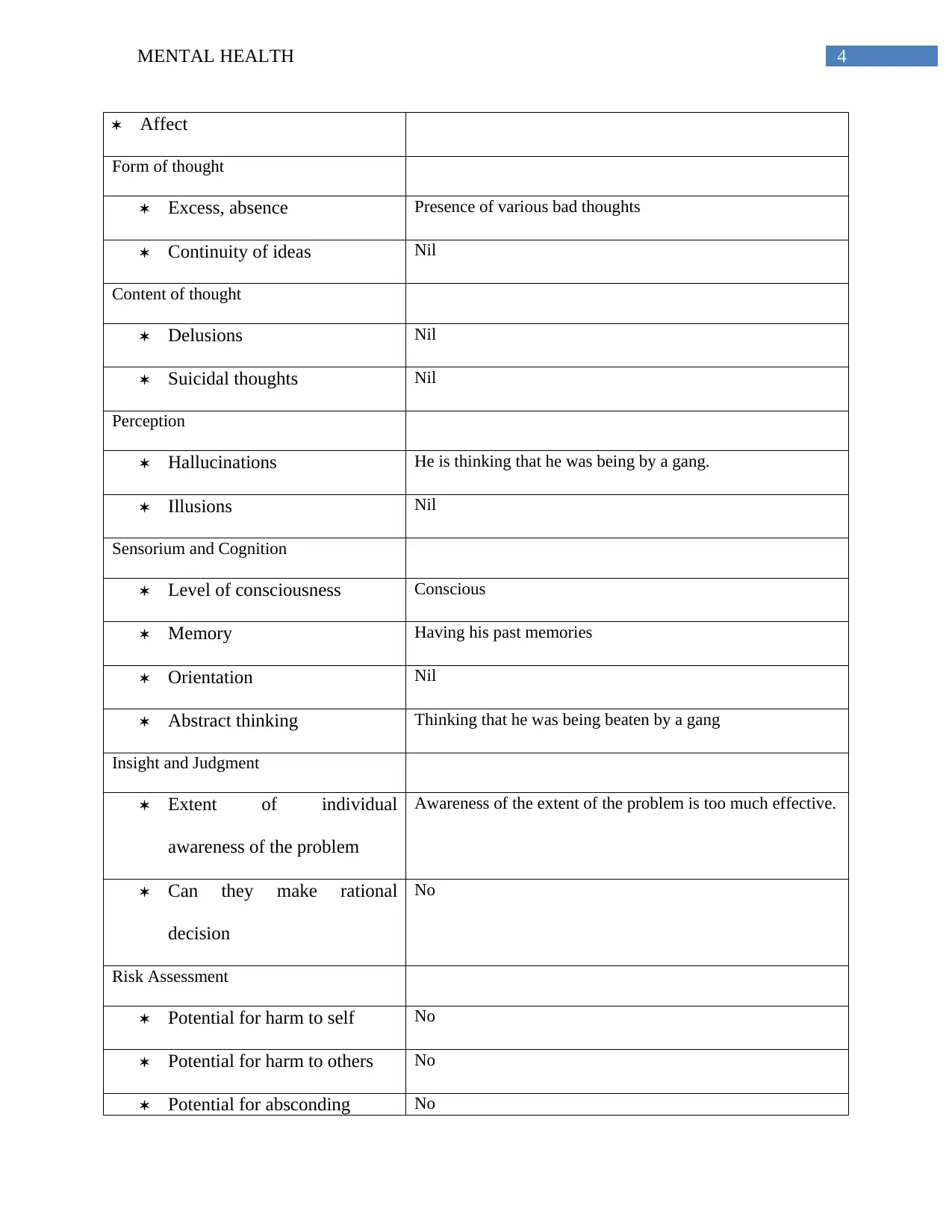
4MENTAL HEALTH
Affect
Form of thought
Excess, absence Presence of various bad thoughts
Continuity of ideas Nil
Content of thought
Delusions Nil
Suicidal thoughts Nil
Perception
Hallucinations He is thinking that he was being by a gang.
Illusions Nil
Sensorium and Cognition
Level of consciousness Conscious
Memory Having his past memories
Orientation Nil
Abstract thinking Thinking that he was being beaten by a gang
Insight and Judgment
Extent of individual
awareness of the problem
Awareness of the extent of the problem is too much effective.
Can they make rational
decision
No
Risk Assessment
Potential for harm to self No
Potential for harm to others No
Potential for absconding No
Affect
Form of thought
Excess, absence Presence of various bad thoughts
Continuity of ideas Nil
Content of thought
Delusions Nil
Suicidal thoughts Nil
Perception
Hallucinations He is thinking that he was being by a gang.
Illusions Nil
Sensorium and Cognition
Level of consciousness Conscious
Memory Having his past memories
Orientation Nil
Abstract thinking Thinking that he was being beaten by a gang
Insight and Judgment
Extent of individual
awareness of the problem
Awareness of the extent of the problem is too much effective.
Can they make rational
decision
No
Risk Assessment
Potential for harm to self No
Potential for harm to others No
Potential for absconding No
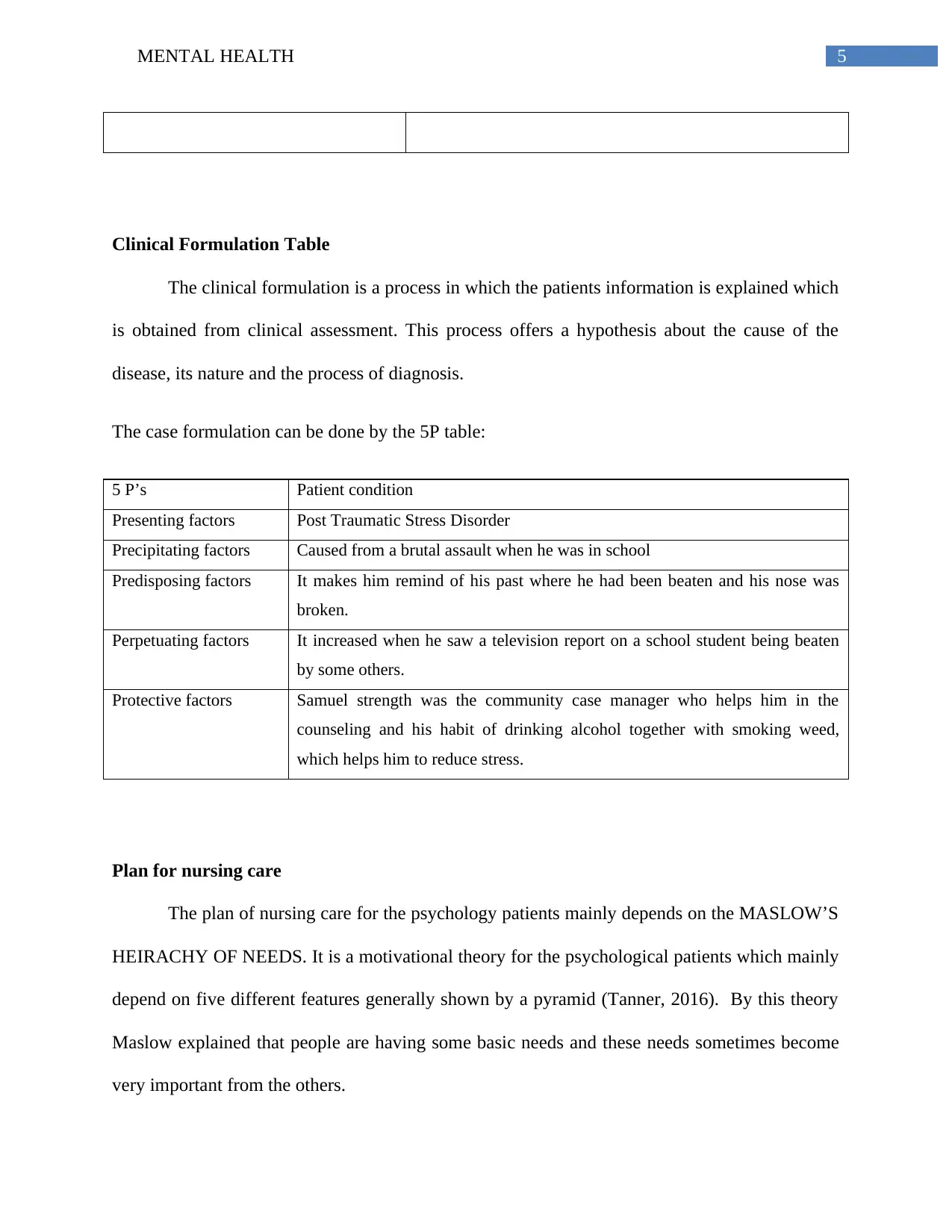
5MENTAL HEALTH
Clinical Formulation Table
The clinical formulation is a process in which the patients information is explained which
is obtained from clinical assessment. This process offers a hypothesis about the cause of the
disease, its nature and the process of diagnosis.
The case formulation can be done by the 5P table:
5 P’s Patient condition
Presenting factors Post Traumatic Stress Disorder
Precipitating factors Caused from a brutal assault when he was in school
Predisposing factors It makes him remind of his past where he had been beaten and his nose was
broken.
Perpetuating factors It increased when he saw a television report on a school student being beaten
by some others.
Protective factors Samuel strength was the community case manager who helps him in the
counseling and his habit of drinking alcohol together with smoking weed,
which helps him to reduce stress.
Plan for nursing care
The plan of nursing care for the psychology patients mainly depends on the MASLOW’S
HEIRACHY OF NEEDS. It is a motivational theory for the psychological patients which mainly
depend on five different features generally shown by a pyramid (Tanner, 2016). By this theory
Maslow explained that people are having some basic needs and these needs sometimes become
very important from the others.
Clinical Formulation Table
The clinical formulation is a process in which the patients information is explained which
is obtained from clinical assessment. This process offers a hypothesis about the cause of the
disease, its nature and the process of diagnosis.
The case formulation can be done by the 5P table:
5 P’s Patient condition
Presenting factors Post Traumatic Stress Disorder
Precipitating factors Caused from a brutal assault when he was in school
Predisposing factors It makes him remind of his past where he had been beaten and his nose was
broken.
Perpetuating factors It increased when he saw a television report on a school student being beaten
by some others.
Protective factors Samuel strength was the community case manager who helps him in the
counseling and his habit of drinking alcohol together with smoking weed,
which helps him to reduce stress.
Plan for nursing care
The plan of nursing care for the psychology patients mainly depends on the MASLOW’S
HEIRACHY OF NEEDS. It is a motivational theory for the psychological patients which mainly
depend on five different features generally shown by a pyramid (Tanner, 2016). By this theory
Maslow explained that people are having some basic needs and these needs sometimes become
very important from the others.
⊘ This is a preview!⊘
Do you want full access?
Subscribe today to unlock all pages.

Trusted by 1+ million students worldwide
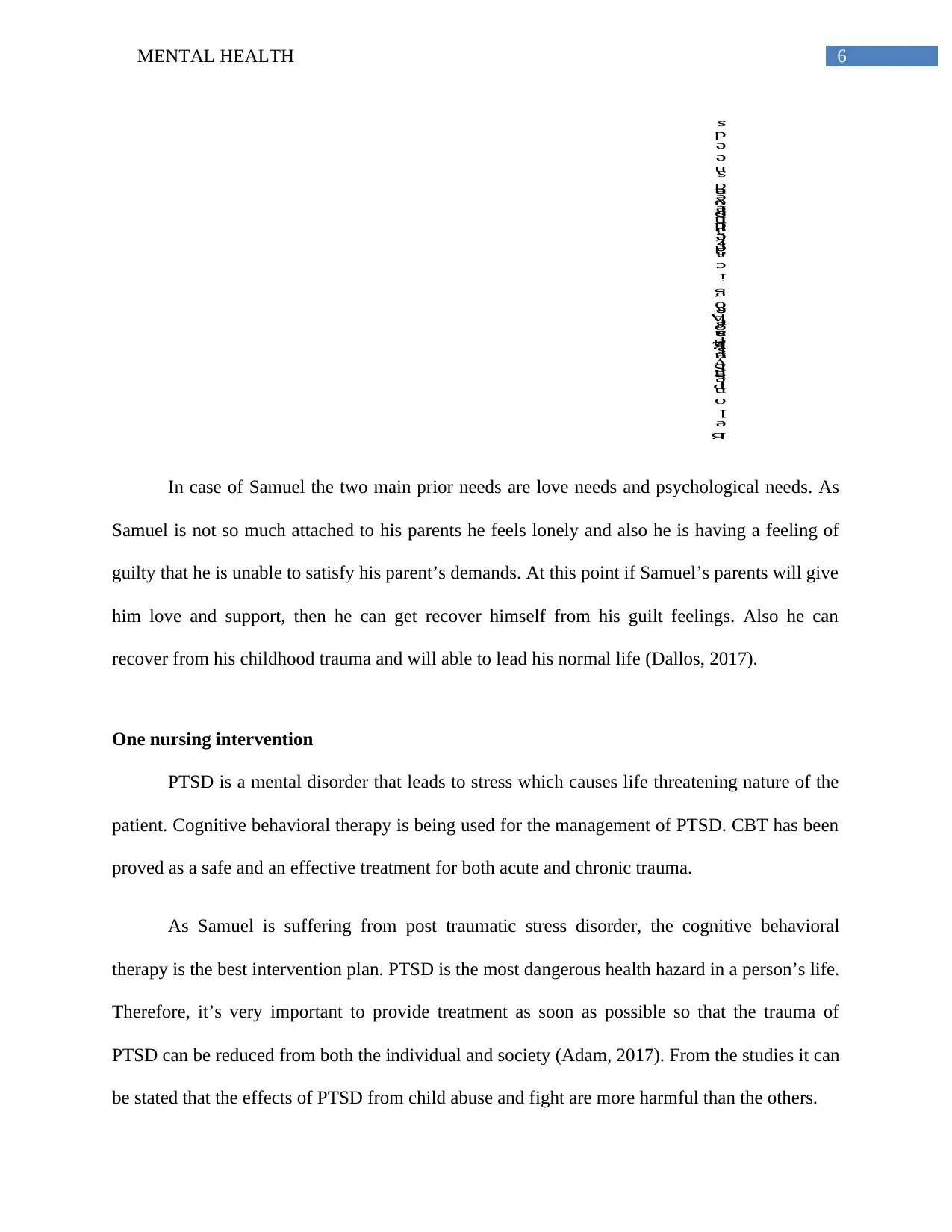
6MENTAL HEALTH
In case of Samuel the two main prior needs are love needs and psychological needs. As
Samuel is not so much attached to his parents he feels lonely and also he is having a feeling of
guilty that he is unable to satisfy his parent’s demands. At this point if Samuel’s parents will give
him love and support, then he can get recover himself from his guilt feelings. Also he can
recover from his childhood trauma and will able to lead his normal life (Dallos, 2017).
One nursing intervention
PTSD is a mental disorder that leads to stress which causes life threatening nature of the
patient. Cognitive behavioral therapy is being used for the management of PTSD. CBT has been
proved as a safe and an effective treatment for both acute and chronic trauma.
As Samuel is suffering from post traumatic stress disorder, the cognitive behavioral
therapy is the best intervention plan. PTSD is the most dangerous health hazard in a person’s life.
Therefore, it’s very important to provide treatment as soon as possible so that the trauma of
PTSD can be reduced from both the individual and society (Adam, 2017). From the studies it can
be stated that the effects of PTSD from child abuse and fight are more harmful than the others.
S
e
l
f
A
c
t
ua
l
i
z
a
t
i
o
n
E
s
t
e
e
m
n
e
e
d
s
B
e
l
o
n
g
i
n
g
n
e
s
s
a
n
d
l
o
v
e
n
e
e
d
s
S
a
f
e
t
y
n
e
e
d
s
P
h
y
s
i
o
l
o
g
i
c
a
l
n
e
e
d
s
In case of Samuel the two main prior needs are love needs and psychological needs. As
Samuel is not so much attached to his parents he feels lonely and also he is having a feeling of
guilty that he is unable to satisfy his parent’s demands. At this point if Samuel’s parents will give
him love and support, then he can get recover himself from his guilt feelings. Also he can
recover from his childhood trauma and will able to lead his normal life (Dallos, 2017).
One nursing intervention
PTSD is a mental disorder that leads to stress which causes life threatening nature of the
patient. Cognitive behavioral therapy is being used for the management of PTSD. CBT has been
proved as a safe and an effective treatment for both acute and chronic trauma.
As Samuel is suffering from post traumatic stress disorder, the cognitive behavioral
therapy is the best intervention plan. PTSD is the most dangerous health hazard in a person’s life.
Therefore, it’s very important to provide treatment as soon as possible so that the trauma of
PTSD can be reduced from both the individual and society (Adam, 2017). From the studies it can
be stated that the effects of PTSD from child abuse and fight are more harmful than the others.
S
e
l
f
A
c
t
ua
l
i
z
a
t
i
o
n
E
s
t
e
e
m
n
e
e
d
s
B
e
l
o
n
g
i
n
g
n
e
s
s
a
n
d
l
o
v
e
n
e
e
d
s
S
a
f
e
t
y
n
e
e
d
s
P
h
y
s
i
o
l
o
g
i
c
a
l
n
e
e
d
s
Paraphrase This Document
Need a fresh take? Get an instant paraphrase of this document with our AI Paraphraser
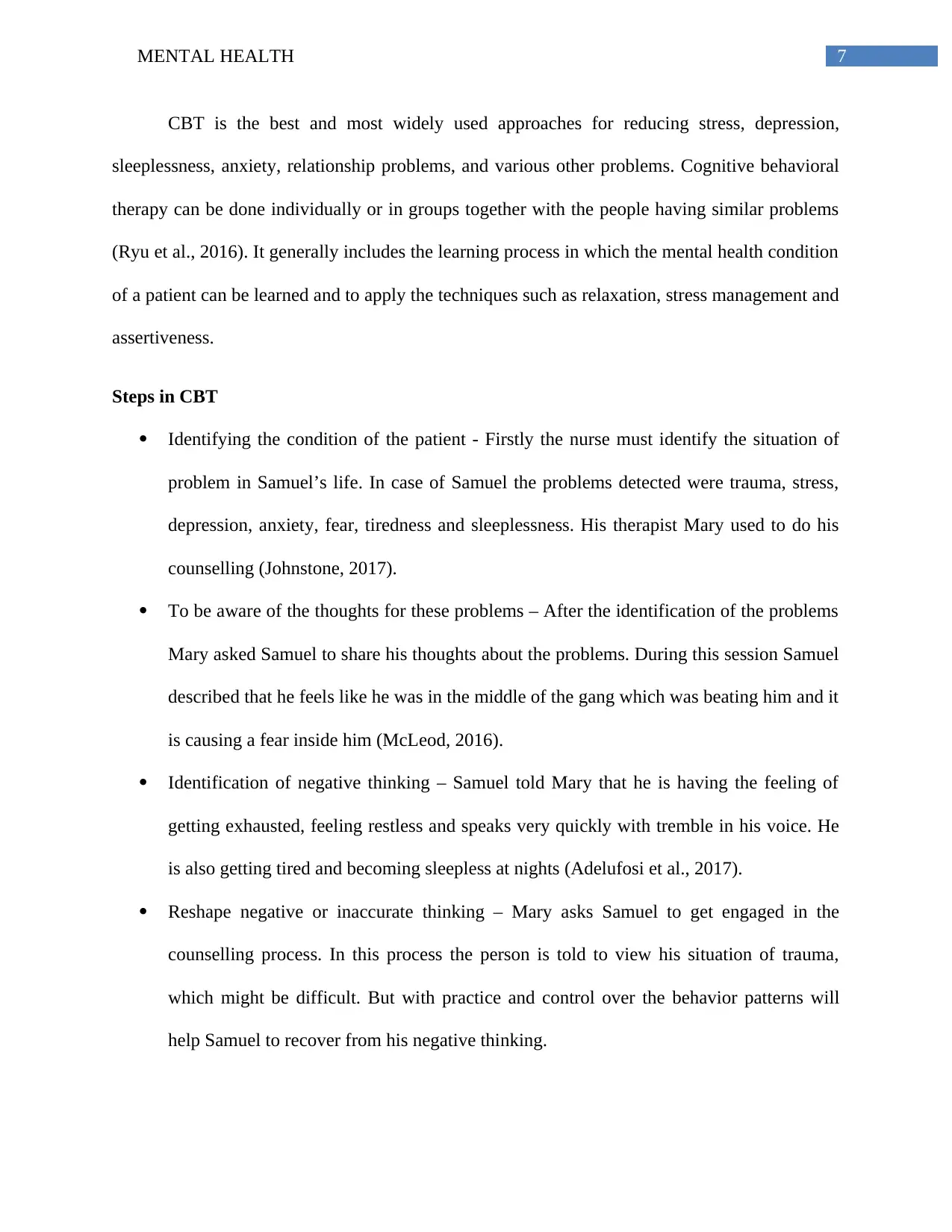
7MENTAL HEALTH
CBT is the best and most widely used approaches for reducing stress, depression,
sleeplessness, anxiety, relationship problems, and various other problems. Cognitive behavioral
therapy can be done individually or in groups together with the people having similar problems
(Ryu et al., 2016). It generally includes the learning process in which the mental health condition
of a patient can be learned and to apply the techniques such as relaxation, stress management and
assertiveness.
Steps in CBT
Identifying the condition of the patient - Firstly the nurse must identify the situation of
problem in Samuel’s life. In case of Samuel the problems detected were trauma, stress,
depression, anxiety, fear, tiredness and sleeplessness. His therapist Mary used to do his
counselling (Johnstone, 2017).
To be aware of the thoughts for these problems – After the identification of the problems
Mary asked Samuel to share his thoughts about the problems. During this session Samuel
described that he feels like he was in the middle of the gang which was beating him and it
is causing a fear inside him (McLeod, 2016).
Identification of negative thinking – Samuel told Mary that he is having the feeling of
getting exhausted, feeling restless and speaks very quickly with tremble in his voice. He
is also getting tired and becoming sleepless at nights (Adelufosi et al., 2017).
Reshape negative or inaccurate thinking – Mary asks Samuel to get engaged in the
counselling process. In this process the person is told to view his situation of trauma,
which might be difficult. But with practice and control over the behavior patterns will
help Samuel to recover from his negative thinking.
CBT is the best and most widely used approaches for reducing stress, depression,
sleeplessness, anxiety, relationship problems, and various other problems. Cognitive behavioral
therapy can be done individually or in groups together with the people having similar problems
(Ryu et al., 2016). It generally includes the learning process in which the mental health condition
of a patient can be learned and to apply the techniques such as relaxation, stress management and
assertiveness.
Steps in CBT
Identifying the condition of the patient - Firstly the nurse must identify the situation of
problem in Samuel’s life. In case of Samuel the problems detected were trauma, stress,
depression, anxiety, fear, tiredness and sleeplessness. His therapist Mary used to do his
counselling (Johnstone, 2017).
To be aware of the thoughts for these problems – After the identification of the problems
Mary asked Samuel to share his thoughts about the problems. During this session Samuel
described that he feels like he was in the middle of the gang which was beating him and it
is causing a fear inside him (McLeod, 2016).
Identification of negative thinking – Samuel told Mary that he is having the feeling of
getting exhausted, feeling restless and speaks very quickly with tremble in his voice. He
is also getting tired and becoming sleepless at nights (Adelufosi et al., 2017).
Reshape negative or inaccurate thinking – Mary asks Samuel to get engaged in the
counselling process. In this process the person is told to view his situation of trauma,
which might be difficult. But with practice and control over the behavior patterns will
help Samuel to recover from his negative thinking.
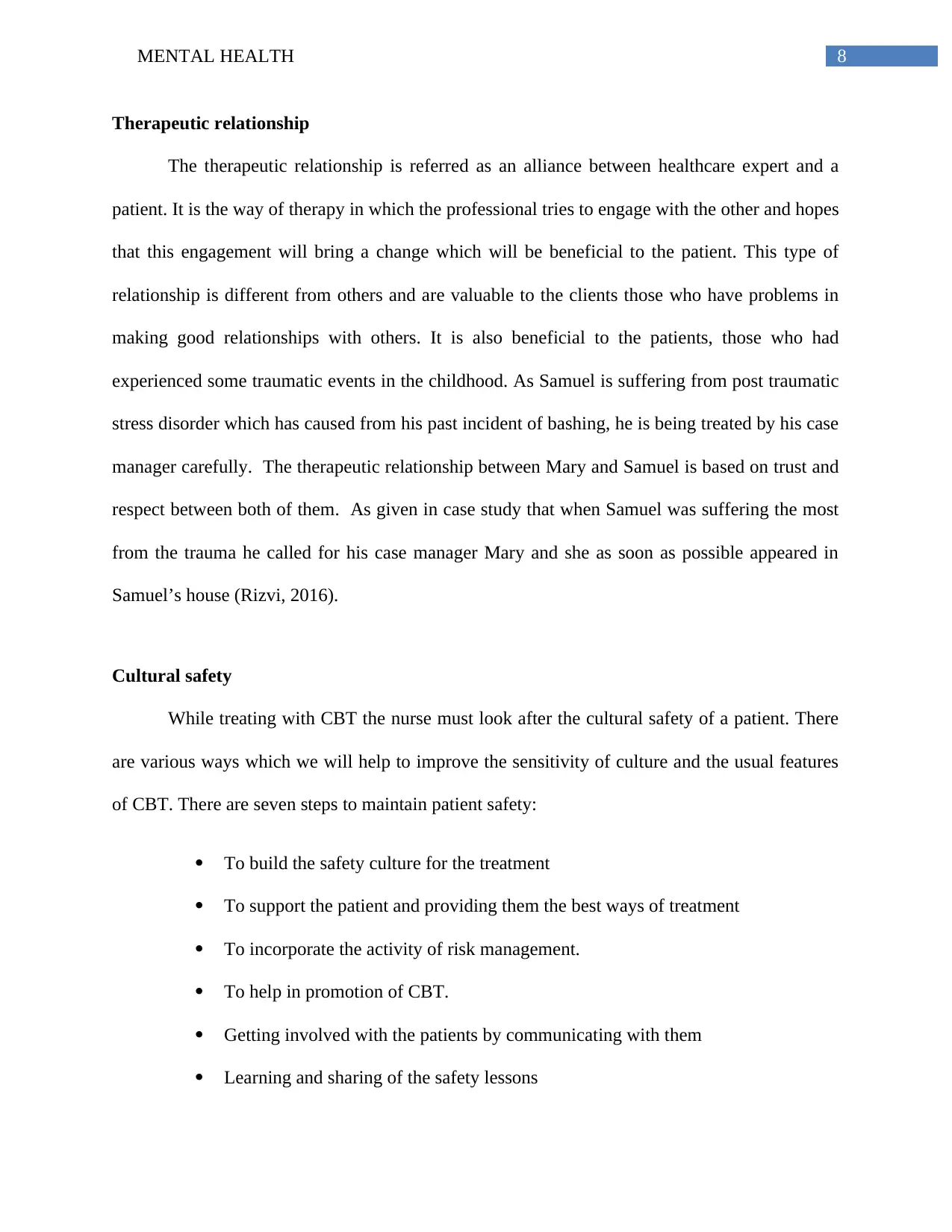
8MENTAL HEALTH
Therapeutic relationship
The therapeutic relationship is referred as an alliance between healthcare expert and a
patient. It is the way of therapy in which the professional tries to engage with the other and hopes
that this engagement will bring a change which will be beneficial to the patient. This type of
relationship is different from others and are valuable to the clients those who have problems in
making good relationships with others. It is also beneficial to the patients, those who had
experienced some traumatic events in the childhood. As Samuel is suffering from post traumatic
stress disorder which has caused from his past incident of bashing, he is being treated by his case
manager carefully. The therapeutic relationship between Mary and Samuel is based on trust and
respect between both of them. As given in case study that when Samuel was suffering the most
from the trauma he called for his case manager Mary and she as soon as possible appeared in
Samuel’s house (Rizvi, 2016).
Cultural safety
While treating with CBT the nurse must look after the cultural safety of a patient. There
are various ways which we will help to improve the sensitivity of culture and the usual features
of CBT. There are seven steps to maintain patient safety:
To build the safety culture for the treatment
To support the patient and providing them the best ways of treatment
To incorporate the activity of risk management.
To help in promotion of CBT.
Getting involved with the patients by communicating with them
Learning and sharing of the safety lessons
Therapeutic relationship
The therapeutic relationship is referred as an alliance between healthcare expert and a
patient. It is the way of therapy in which the professional tries to engage with the other and hopes
that this engagement will bring a change which will be beneficial to the patient. This type of
relationship is different from others and are valuable to the clients those who have problems in
making good relationships with others. It is also beneficial to the patients, those who had
experienced some traumatic events in the childhood. As Samuel is suffering from post traumatic
stress disorder which has caused from his past incident of bashing, he is being treated by his case
manager carefully. The therapeutic relationship between Mary and Samuel is based on trust and
respect between both of them. As given in case study that when Samuel was suffering the most
from the trauma he called for his case manager Mary and she as soon as possible appeared in
Samuel’s house (Rizvi, 2016).
Cultural safety
While treating with CBT the nurse must look after the cultural safety of a patient. There
are various ways which we will help to improve the sensitivity of culture and the usual features
of CBT. There are seven steps to maintain patient safety:
To build the safety culture for the treatment
To support the patient and providing them the best ways of treatment
To incorporate the activity of risk management.
To help in promotion of CBT.
Getting involved with the patients by communicating with them
Learning and sharing of the safety lessons
⊘ This is a preview!⊘
Do you want full access?
Subscribe today to unlock all pages.

Trusted by 1+ million students worldwide
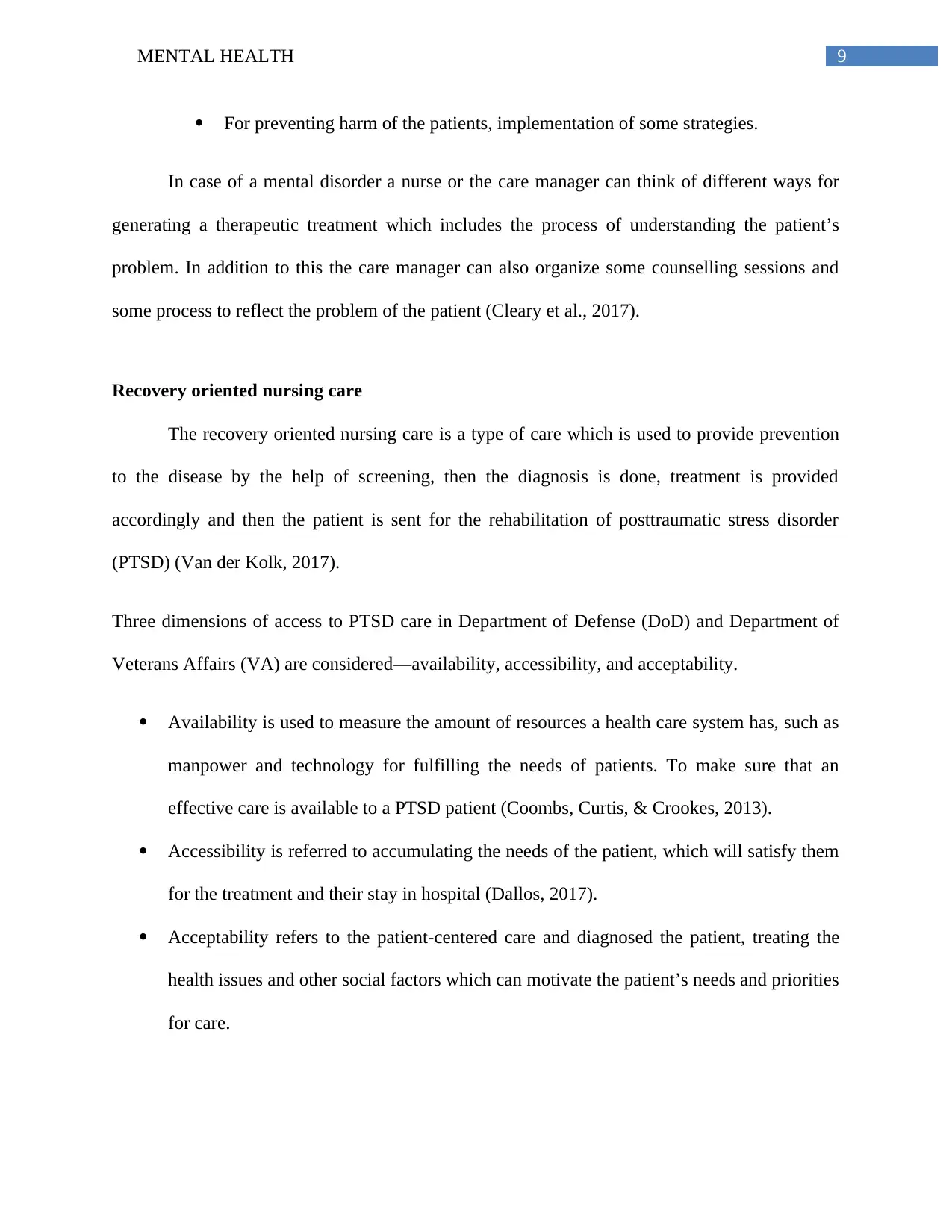
9MENTAL HEALTH
For preventing harm of the patients, implementation of some strategies.
In case of a mental disorder a nurse or the care manager can think of different ways for
generating a therapeutic treatment which includes the process of understanding the patient’s
problem. In addition to this the care manager can also organize some counselling sessions and
some process to reflect the problem of the patient (Cleary et al., 2017).
Recovery oriented nursing care
The recovery oriented nursing care is a type of care which is used to provide prevention
to the disease by the help of screening, then the diagnosis is done, treatment is provided
accordingly and then the patient is sent for the rehabilitation of posttraumatic stress disorder
(PTSD) (Van der Kolk, 2017).
Three dimensions of access to PTSD care in Department of Defense (DoD) and Department of
Veterans Affairs (VA) are considered—availability, accessibility, and acceptability.
Availability is used to measure the amount of resources a health care system has, such as
manpower and technology for fulfilling the needs of patients. To make sure that an
effective care is available to a PTSD patient (Coombs, Curtis, & Crookes, 2013).
Accessibility is referred to accumulating the needs of the patient, which will satisfy them
for the treatment and their stay in hospital (Dallos, 2017).
Acceptability refers to the patient-centered care and diagnosed the patient, treating the
health issues and other social factors which can motivate the patient’s needs and priorities
for care.
For preventing harm of the patients, implementation of some strategies.
In case of a mental disorder a nurse or the care manager can think of different ways for
generating a therapeutic treatment which includes the process of understanding the patient’s
problem. In addition to this the care manager can also organize some counselling sessions and
some process to reflect the problem of the patient (Cleary et al., 2017).
Recovery oriented nursing care
The recovery oriented nursing care is a type of care which is used to provide prevention
to the disease by the help of screening, then the diagnosis is done, treatment is provided
accordingly and then the patient is sent for the rehabilitation of posttraumatic stress disorder
(PTSD) (Van der Kolk, 2017).
Three dimensions of access to PTSD care in Department of Defense (DoD) and Department of
Veterans Affairs (VA) are considered—availability, accessibility, and acceptability.
Availability is used to measure the amount of resources a health care system has, such as
manpower and technology for fulfilling the needs of patients. To make sure that an
effective care is available to a PTSD patient (Coombs, Curtis, & Crookes, 2013).
Accessibility is referred to accumulating the needs of the patient, which will satisfy them
for the treatment and their stay in hospital (Dallos, 2017).
Acceptability refers to the patient-centered care and diagnosed the patient, treating the
health issues and other social factors which can motivate the patient’s needs and priorities
for care.
Paraphrase This Document
Need a fresh take? Get an instant paraphrase of this document with our AI Paraphraser
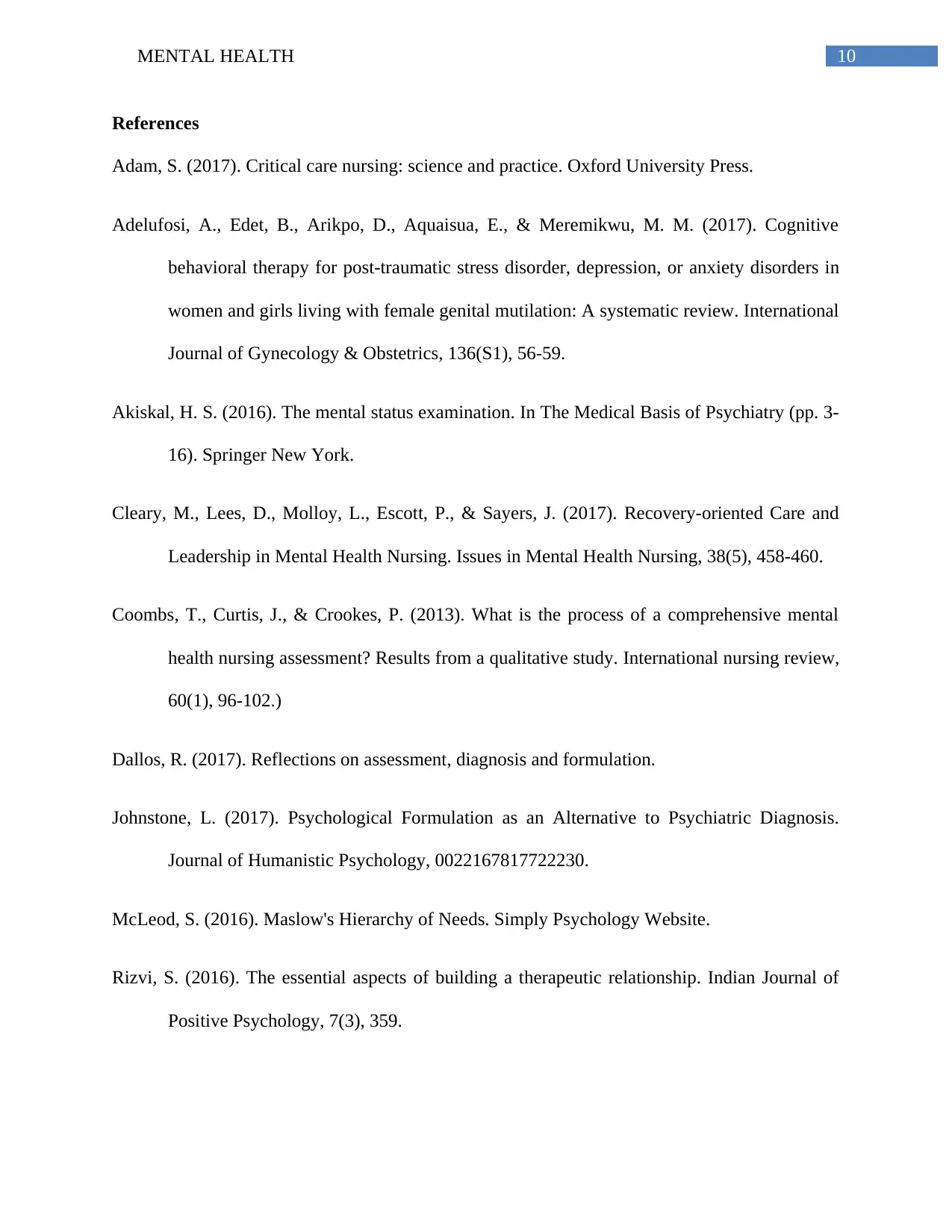
10MENTAL HEALTH
References
Adam, S. (2017). Critical care nursing: science and practice. Oxford University Press.
Adelufosi, A., Edet, B., Arikpo, D., Aquaisua, E., & Meremikwu, M. M. (2017). Cognitive
behavioral therapy for post‐traumatic stress disorder, depression, or anxiety disorders in
women and girls living with female genital mutilation: A systematic review. International
Journal of Gynecology & Obstetrics, 136(S1), 56-59.
Akiskal, H. S. (2016). The mental status examination. In The Medical Basis of Psychiatry (pp. 3-
16). Springer New York.
Cleary, M., Lees, D., Molloy, L., Escott, P., & Sayers, J. (2017). Recovery-oriented Care and
Leadership in Mental Health Nursing. Issues in Mental Health Nursing, 38(5), 458-460.
Coombs, T., Curtis, J., & Crookes, P. (2013). What is the process of a comprehensive mental
health nursing assessment? Results from a qualitative study. International nursing review,
60(1), 96-102.)
Dallos, R. (2017). Reflections on assessment, diagnosis and formulation.
Johnstone, L. (2017). Psychological Formulation as an Alternative to Psychiatric Diagnosis.
Journal of Humanistic Psychology, 0022167817722230.
McLeod, S. (2016). Maslow's Hierarchy of Needs. Simply Psychology Website.
Rizvi, S. (2016). The essential aspects of building a therapeutic relationship. Indian Journal of
Positive Psychology, 7(3), 359.
References
Adam, S. (2017). Critical care nursing: science and practice. Oxford University Press.
Adelufosi, A., Edet, B., Arikpo, D., Aquaisua, E., & Meremikwu, M. M. (2017). Cognitive
behavioral therapy for post‐traumatic stress disorder, depression, or anxiety disorders in
women and girls living with female genital mutilation: A systematic review. International
Journal of Gynecology & Obstetrics, 136(S1), 56-59.
Akiskal, H. S. (2016). The mental status examination. In The Medical Basis of Psychiatry (pp. 3-
16). Springer New York.
Cleary, M., Lees, D., Molloy, L., Escott, P., & Sayers, J. (2017). Recovery-oriented Care and
Leadership in Mental Health Nursing. Issues in Mental Health Nursing, 38(5), 458-460.
Coombs, T., Curtis, J., & Crookes, P. (2013). What is the process of a comprehensive mental
health nursing assessment? Results from a qualitative study. International nursing review,
60(1), 96-102.)
Dallos, R. (2017). Reflections on assessment, diagnosis and formulation.
Johnstone, L. (2017). Psychological Formulation as an Alternative to Psychiatric Diagnosis.
Journal of Humanistic Psychology, 0022167817722230.
McLeod, S. (2016). Maslow's Hierarchy of Needs. Simply Psychology Website.
Rizvi, S. (2016). The essential aspects of building a therapeutic relationship. Indian Journal of
Positive Psychology, 7(3), 359.
1 out of 11
Related Documents
Your All-in-One AI-Powered Toolkit for Academic Success.
+13062052269
info@desklib.com
Available 24*7 on WhatsApp / Email
![[object Object]](/_next/static/media/star-bottom.7253800d.svg)
Unlock your academic potential
Copyright © 2020–2025 A2Z Services. All Rights Reserved. Developed and managed by ZUCOL.





